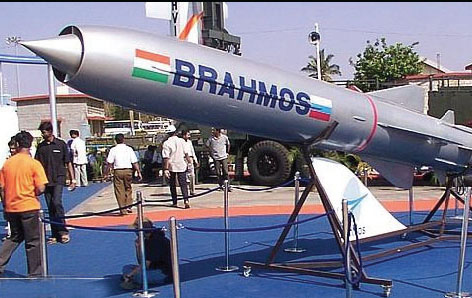 INDIA’S missile programme got further boost on July 29, 2012 with the successful test firing of BrahMos supersonic cruise missile as part of a user trial by the Army. It was the 32nd test firing of the nuclear capable missile which can carry a 300-kilogram conventional warhead up to 290 kilometers (180 miles) and would soon be deployed on the India-China border.
INDIA’S missile programme got further boost on July 29, 2012 with the successful test firing of BrahMos supersonic cruise missile as part of a user trial by the Army. It was the 32nd test firing of the nuclear capable missile which can carry a 300-kilogram conventional warhead up to 290 kilometers (180 miles) and would soon be deployed on the India-China border.
BrahMos is a two-stage missile with a solid propellant booster engine as its first stage which brings it to supersonic speed and then gets separated. BrahMos is the first supersonic cruise missile known to be in service and is deployed on INS Rajput since 2005. The missile has “fire and forget” principle, adopting varieties of flights on its way to the target. Its destructive power is enhanced due to large kinetic energy on impact. Its cruising altitude could be up to 15 km (9.3 miles) and terminal altitude is as low as 10 meters.
 Compared to existing state-of-the-art subsonic cruise missiles, BrahMos has three times more velocity, 2.5 to 3 times more flight range, 3 to 4 times more seeker range and 9 times more kinetic energy. The missile has identical configuration for land, sea and sub-sea platforms and uses a Transport Launch Canister (TLC) for transportation, storage and launch. The missile is universal for multiple platforms and can pin point accuracy with high lethal power aided by large kinetic energy on impact. It has shorter flight times leading to lower target dispersion and quicker engagement.
Compared to existing state-of-the-art subsonic cruise missiles, BrahMos has three times more velocity, 2.5 to 3 times more flight range, 3 to 4 times more seeker range and 9 times more kinetic energy. The missile has identical configuration for land, sea and sub-sea platforms and uses a Transport Launch Canister (TLC) for transportation, storage and launch. The missile is universal for multiple platforms and can pin point accuracy with high lethal power aided by large kinetic energy on impact. It has shorter flight times leading to lower target dispersion and quicker engagement.
So far India has deployed BrahMos missile in the western sector only against Pakistan. However, since the missile is fitted on a mobile launcher it can be transported anywhere in the country and deployed within a short time. The Indian Army is planning to deploy it against China as well in near future. India started a massive war preparedness drill in Arunachal Pradesh in the north-eastern sector codenamed “Pralaya” on February 29, 2012.
BrahMos is a stealth supersonic cruise missile that can be launched from submarines, ships, aircraft or land. It is about three-and-a-half times faster than the USA”s subsonic Harpoon cruise missile and three times faster than USA”s subsonic Tomahawk missile. India has also planned an air-launched variant which is expected to come out in 2012 and will make India the only country with supersonic missiles in all the defense forces. However, the 2012 deadline is unlikely to be met.
A hypersonic version of the missile, which is also presently under development with speed of Mach 7 to boost aerial fast strike capability, is expected to be ready by 2016. BrahMos has the capability of attacking surface targets by flying as low as 10 meters.
The air launch version and the submarine launch version of the missile system are in progress. The Indian Army has so far placed orders for the BrahMos missile to be deployed by three regiments of the Army and two of them have already been inducted operationally. A hypersonic version of the missile, which is also presently under development with speed of Mach 7 to boost aerial fast strike capability, is expected to be ready by 2016.
The army and navy versions of the BrahMos missile weigh three tons or more. The missile is also available for exports whosoever is interested in it as long as they are ready to shell out about $2-3 million apiece. The cost depends on the version. The BrahMos has been developed as a joint venture between the Defence Research and Development Organization (DRDO) of India and the Federal State Unitary Enterprise NPO Mashinostroyenia (NPOM) of Russia under BrahMos Aerospace. The missile is named after two rivers, the Brahmaputra of India and the Moskva of Russia.













Comments